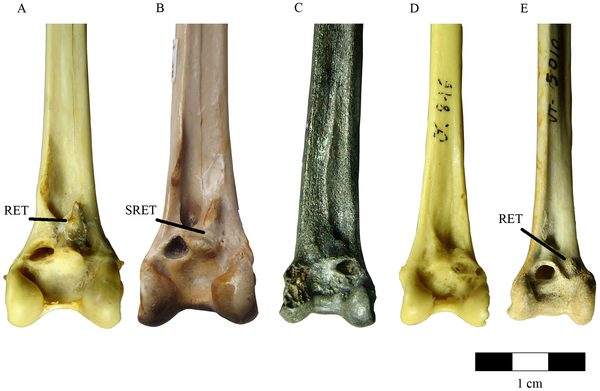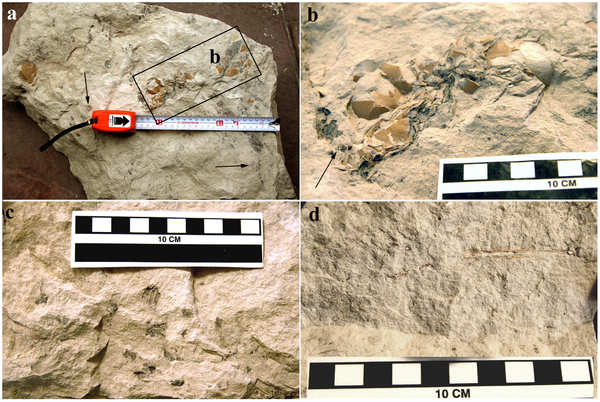We describe the first occurrence in the fossil record of an aquatic avian twig-nest with five eggs in situ (Early Miocene Tudela Formation, Ebro Basin, Spain). Extensive outcrops of this formation reveal autochthonous avian osteological and oological fossils that represent a single taxon identified as a basal phoenicopterid. Although the eggshell structure is definitively phoenicopterid, the characteristics of both the nest and the eggs are similar to those of modern grebes. These observations allow us to address the origin of the disparities between the sister taxa Podicipedidae and Phoenicopteridae crown clades, and traces the evolution of the nesting and reproductive environments for phoenicopteriforms.

Comparison of the Palaelodidae and Phoenicopteridae distal tibiotarsi.
(a) Phoenicopterus ruber (MZUSP 88485); (b) BAS new species; (c) Agnopterus sicki (MHNT 4257); (d) Phoenicopterus croizeti (MHNT 5085); (e) Palaelodus spp. (MHNT 5010). The most diagnostic characters found in BAS are a crest in the Retinaculum Extensorium Tibiotarsi (RET) divided by a deep and conspicuous sulcus from the articular facet for the intercotylar eminence of the tarsometatarsus (b), a deep intercondylar incision extending over the lateral condyle, a tuberosity for the RET medial attachment and a deep sulcus surrounded by crests cranial to the trochlea cartilaginis tibialis (not shown). RET: Retinaculum Extensorium Tibiotarsi. SRET: sulcus between the RET and the articular facet for the intercotylar eminence of the tarsometatarsus in the BAS specimen.
doi:10.1371/journal.pone.0046972.g006
Methodology/Principal Findings
Multi-disciplinary analyses performed on fossilized vegetation and eggshells from the eggs in the nest and its embedding sediments indicate that this new phoenicopterid thrived under a semi-arid climate in an oligohaline (seasonally mesohaline) shallow endorheic lacustine environment. High-end microcharacterizations including SEM, TEM, and EBSD techniques were pivotal to identifying these phoenicopterid eggshells. Anatomical comparisons of the fossil bones with those of Phoenicopteriformes and Podicipediformes crown clades and extinct palaelodids confirm that this avian fossil assemblage belongs to a new and basal phoenicopterid.
Conclusions/Significance
Although the Podicipediformes-Phoenicopteriformes sister group relationship is now well supported, flamingos and grebes exhibit feeding, reproductive, and nesting strategies that diverge significantly. Our multi-disciplinary study is the first to reveal that the phoenicopteriform reproductive behaviour, nesting ecology and nest characteristics derived from grebe-like type strategies to reach the extremely specialized conditions observed in modern flamingo crown groups. Furthermore, our study enables us to map ecological and reproductive characters on the Phoenicopteriformes evolutionary lineage. Our results demonstrate that the nesting paleoenvironments of flamingos were closely linked to the unique ecology of this locality, which is a direct result of special climatic (high evaporitic regime) and geological (fault system) conditions.
Citation: Grellet-Tinner G, Murelaga X, Larrasoaña JC, Silveira LF, Olivares M, et al. (2012) The First Occurrence in the Fossil Record of an Aquatic Avian Twig-Nest with Phoenicopteriformes Eggs: Evolutionary Implications. PLoS ONE 7(10): e46972. doi:10.1371/journal.pone.0046972
Editor: Lee A. Newsom, The Pennsylvania State University, United States of America



 August 6th, 2013
August 6th, 2013  Riffin
Riffin 
 Posted in
Posted in  Tags:
Tags: 